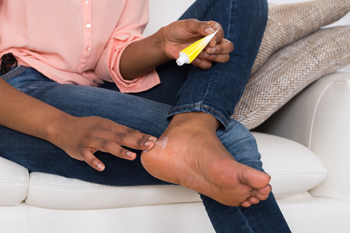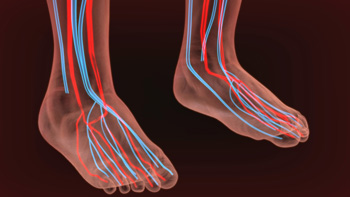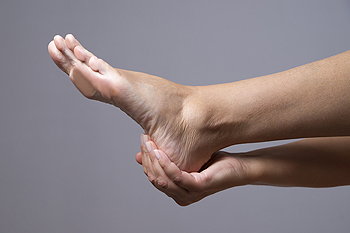Items filtered by date: February 2019
Reasons for Cracked Heels to Develop
 Many people experience cracked heels, and if it begins in childhood, genetic reasons may be the cause. If it starts as an adult, the reasons may be environmental or hormonal. Additionally, medical conditions, which may include eczema and psoriasis, may play a significant role in developing cracked heels. It typically appears as a thickening of the skin on the heel, and deep cracks, or fissures may form if left untreated. Patients who wear open-back sandals or who stand for extended periods of time during the day may find they have cracked heels. Mild relief may be found when washing and drying the feet thoroughly, followed by utilizing a good moisturizer. If you have cracked heels that are painful, it is suggested to speak to a podiatrist who can properly treat this condition.
Many people experience cracked heels, and if it begins in childhood, genetic reasons may be the cause. If it starts as an adult, the reasons may be environmental or hormonal. Additionally, medical conditions, which may include eczema and psoriasis, may play a significant role in developing cracked heels. It typically appears as a thickening of the skin on the heel, and deep cracks, or fissures may form if left untreated. Patients who wear open-back sandals or who stand for extended periods of time during the day may find they have cracked heels. Mild relief may be found when washing and drying the feet thoroughly, followed by utilizing a good moisturizer. If you have cracked heels that are painful, it is suggested to speak to a podiatrist who can properly treat this condition.
Cracked heels are unsightly and can cause further damage to your shoes and feet. If you have any concerns, contact Dr. Odin De Los Reyes from Connecticut. Our doctor can provide the care you need to keep you pain-free and on your feet.
Cracked Heels
Cracked heels appear unappealing and can make it harder for you walk around in sandals. Aside from looking unpleasant, cracked heels can also tear stockings, socks, and wear out your shoes. There are several methods to help restore a cracked heel and prevent further damage.
How Do You Get Them?
Dry skin is the number one culprit in creating cracked heels. Many athletes, walkers, joggers, and even swimmers suffer from cracked heels. Age and skin oil production play a role to getting cracked heels as well.
Promote Healing
Over the counter medicines can help, especially for those that need instant relief or who suffer from chronic dry feet.
Wear Socks – Wearing socks with medicated creams helps lock in moisture.
Moisturizers – Applying both day and night will help alleviate dryness which causes cracking.
Pumice Stones – These exfoliate and remove dead skin, which allows for smoother moisturizer application and better absorption into the skin.
Change in Diet
Eating healthy with a well-balanced diet will give the skin a fresh and radiant look. Your body responds to the kinds of food you ingest. Omega-3 fatty acids and zinc supplements can also revitalize skin tissue.
Most importantly, seek professional help if unsure how to proceed in treating cracked heels. A podiatrist will help you with any questions or information needed.
If you have any questions, please feel free to contact our offices located in Southbury and Farmington, CT . We offer the newest diagnostic and treatment technologies for all your foot care needs.
Causes of Poor Circulation
 The medical condition that is referred to as poor circulation can be an indication of health issues that may exist in the body. It may be caused by poor dietary habits or sitting for extended periods of time. Additional causes may consist of diabetes, peripheral artery disease (PAD), or blood clots in the legs. Many patients experience symptoms that are indicative of poor circulation, and these may include a lack of energy, feet that are cold the majority of the time, or a tingling or numbing sensation in the hands and feet. Other symptoms may consist of having a poor memory, a weakened immune system, or a loss of appetite. Research has indicated that maintaining a healthy diet and engaging in an exercise regime may be helpful in treating poor circulation. It’s important to drink plenty of fresh water daily, in addition to avoiding alcohol. If poor circulation is affecting your feet, it is suggested to speak to a podiatrist who can properly diagnose and treat this condition.
The medical condition that is referred to as poor circulation can be an indication of health issues that may exist in the body. It may be caused by poor dietary habits or sitting for extended periods of time. Additional causes may consist of diabetes, peripheral artery disease (PAD), or blood clots in the legs. Many patients experience symptoms that are indicative of poor circulation, and these may include a lack of energy, feet that are cold the majority of the time, or a tingling or numbing sensation in the hands and feet. Other symptoms may consist of having a poor memory, a weakened immune system, or a loss of appetite. Research has indicated that maintaining a healthy diet and engaging in an exercise regime may be helpful in treating poor circulation. It’s important to drink plenty of fresh water daily, in addition to avoiding alcohol. If poor circulation is affecting your feet, it is suggested to speak to a podiatrist who can properly diagnose and treat this condition.
While poor circulation itself isn’t a condition; it is a symptom of another underlying health condition you may have. If you have any concerns with poor circulation in your feet contact Dr. Odin De Los Reyes of Connecticut. Our doctor will treat your foot and ankle needs.
Poor Circulation in the Feet
Peripheral artery disease (PAD) can potentially lead to poor circulation in the lower extremities. PAD is a condition that causes the blood vessels and arteries to narrow. In a linked condition called atherosclerosis, the arteries stiffen up due to a buildup of plaque in the arteries and blood vessels. These two conditions can cause a decrease in the amount of blood that flows to your extremities, therefore resulting in pain.
Symptoms
Some of the most common symptoms of poor circulation are:
- Numbness
- Tingling
- Throbbing or stinging pain in limbs
- Pain
- Muscle Cramps
Treatment for poor circulation often depends on the underlying condition that causes it. Methods for treatment may include insulin for diabetes, special exercise programs, surgery for varicose veins, or compression socks for swollen legs.
As always, see a podiatrist as he or she will assist in finding a regimen that suits you. A podiatrist can also prescribe you any needed medication.
If you have any questions, please feel free to contact our offices located in Southbury and Farmington, CT . We offer the newest diagnostic and treatment technologies for all your foot care needs.
Stretches That Can Help Sever’s Disease
 Sever’s disease is a painful heel condition that only affects children. Swelling of the growth plate is what causes this disease, along with discomfort and pain. Children that are involved in sports are more likely to have this affiliation, because injuries to the growth plate are caused by weight-bearing activities. Stretching can help to prevent Sever’s disease, and it can also assist in the healing process. Movements that stretch the hamstring, calf muscles, and tendons on the back of the leg should be performed 2 to 3 times a day, with the stretch being held for around 20 seconds. Even if there is only pain in one heel, the stretches should be done with both legs. Exercises that strengthen the muscles surrounding the shin will also help alleviate some discomfort and help to prevent this condition from developing again. If you think your child may have Sever’s Disease, then it is highly recommended to consult with a podiatrist in order to receive more information and proper treatment.
Sever’s disease is a painful heel condition that only affects children. Swelling of the growth plate is what causes this disease, along with discomfort and pain. Children that are involved in sports are more likely to have this affiliation, because injuries to the growth plate are caused by weight-bearing activities. Stretching can help to prevent Sever’s disease, and it can also assist in the healing process. Movements that stretch the hamstring, calf muscles, and tendons on the back of the leg should be performed 2 to 3 times a day, with the stretch being held for around 20 seconds. Even if there is only pain in one heel, the stretches should be done with both legs. Exercises that strengthen the muscles surrounding the shin will also help alleviate some discomfort and help to prevent this condition from developing again. If you think your child may have Sever’s Disease, then it is highly recommended to consult with a podiatrist in order to receive more information and proper treatment.
Sever's disease often occurs in children and teens. If your child is experiencing foot or ankle pain, see Dr. Odin De Los Reyes from Connecticut. Our doctor can treat your child’s foot and ankle needs.
Sever’s Disease
Sever’s disease is also known as calcaneal apophysitis, which is a medical condition that causes heel pain I none or both feet. The disease is known to affect children between the ages of 8 and 14.
Sever’s disease occurs when part of the child’s heel known as the growth plate (calcaneal epiphysis) is attached to the Achilles tendon. This area can suffer injury when the muscles and tendons of the growing foot do not keep pace with bone growth. Therefore, the constant pain which one experiences at the back of the heel will make the child unable to put any weight on the heel. The child is then forced to walk on their toes.
Symptoms
Acute pain – Pain associated with Sever’s disease is usually felt in the heel when the child engages in physical activity such as walking, jumping and or running.
Highly active – Children who are very active are among the most susceptible in experiencing Sever’s disease, because of the stress and tension placed on their feet.
If you have any questions, please feel free to contact our offices located in Southbury and Farmington, CT . We offer the newest diagnostic and treatment technologies for all your foot and ankle injuries.
What Is a Plantar Wart?
 If you notice a small thickened area in the heel or bottom of your foot producing severe pain and discomfort, you may have what is referred to as a verruca wart, which is more commonly known as a plantar wart. It is caused by the human papillomavirus (HPV), and will typically attack the skin on the bottom of the feet. It typically lives and thrives in moist and warm environments which may include public pools and surrounding areas, shower room floors and locker rooms. It is known to enter the body through tiny cracks in the skin and grows into the heel as a result of pressure the foot endures while walking. Many people may notice a small and callused area where the wart has formed, and small black dots may be present in the center. If you have developed a plantar wart, please speak to a podiatrist who can properly treat this condition.
If you notice a small thickened area in the heel or bottom of your foot producing severe pain and discomfort, you may have what is referred to as a verruca wart, which is more commonly known as a plantar wart. It is caused by the human papillomavirus (HPV), and will typically attack the skin on the bottom of the feet. It typically lives and thrives in moist and warm environments which may include public pools and surrounding areas, shower room floors and locker rooms. It is known to enter the body through tiny cracks in the skin and grows into the heel as a result of pressure the foot endures while walking. Many people may notice a small and callused area where the wart has formed, and small black dots may be present in the center. If you have developed a plantar wart, please speak to a podiatrist who can properly treat this condition.
Plantar warts can be very uncomfortable. If you need your feet checked, contact Dr. Odin De Los Reyes from Connecticut. Our doctor will assist you with all of your foot and ankle needs.
About Plantar Warts
Plantar warts are the result of HPV, or human papillomavirus, getting into open wounds on the feet. They are mostly found on the heels or balls of the feet.
While plantar warts are generally harmless, those experiencing excessive pain or those suffering from diabetes or a compromised immune system require immediate medical care. Plantar warts are easily diagnosed, usually through scraping off a bit of rough skin or by getting a biopsy.
Symptoms
- Lesions on the bottom of your feet, usually rough and grainy
- Hard or thick callused spots
- Wart seeds, which are small clotted blood vessels that look like little black spots
- Pain, discomfort, or tenderness of your feet when walking or standing
Treatment
- Freezing
- Electric tool removal
- Laser Treatment
- Topical Creams (prescription only)
- Over-the-counter medications
To help prevent developing plantar warts, avoid walking barefoot over abrasive surfaces that can cause cuts or wounds for HPV to get into. Avoiding direct contact with other warts, as well as not picking or rubbing existing warts, can help prevent the further spread of plantar warts. However, if you think you have developed plantar warts, speak to your podiatrist. He or she can diagnose the warts on your feet and recommend the appropriate treatment options.
If you have any questions please feel free to contact our offices located in Southbury and Farmington, CT . We offer the newest diagnostic and treatment technologies for all your foot and ankle needs.
